The Global Emotions Report. Happiest and most stressed people around the world
While measurements like the unemployment rate and the GDP are a traditional way to quantify certain aspects of a society’s state, behavioural economics shows that emotions could also represent a good metric.
One might argue that sentiment and emotions are „soft data” but this field of study suggests that 70% of the human behaviour is based on emotions and only 30% is rational, which means that the emotional state of a country could offer insight into a country’s outlook.
Gallup released its latest survey on 142 countries assessing the level of happiness and well-being, as well as that of stress and other negative experiences.
The Gallup 2017 Global Emotions Report presents the results of the latest measurements of people’s positive and negative daily experiences based on nearly 149,000 answers and quantifies “what makes a life worth living.”
Like unemployment statistics, the results from these questions are aggregated to produce national-level figures. See which countries lead in positive and negative experiences, including laughter, rest, enjoyment, anger, stress and worry.
Positive Experience Index. The happiest countries in the world
Gallup asked adults in 142 countries in 2016 if they had five positive experiences on the day before the survey.
Ecuador, El Salvador and Liberia top the list of the most emotional countries in the world in 2016. On average, nearly six in 10 residents in each of these countries reported experiencing positive or negative emotions the previous day.
At the opposite end are countries such as Russia or from the former Soviet Union where fewer than four in 10 residents reported experiencing any of these feelings.
Percentages range from a high of 60% in Ecuador to a low of 37% in Belarus.
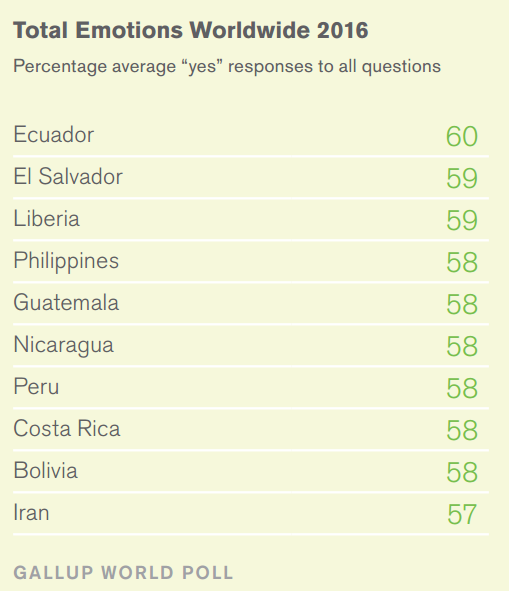
More than 70% of people worldwide said they experienced a lot of enjoyment, smiled or laughed a lot, felt well-rested, and felt treated with respect. People were also asked if they learned or did something interesting the day before.
They were far less likely to say they learned or did something interesting the day before the interview — just 50% said this was their experience. While this percentage might seem low compared with the results for other metrics, it is on the higher end of scores over the past decade.
Through 2012, majorities of adults worldwide said they did not learn or do something interesting the previous day.
Scores worldwide ranged from a high of 84 in Paraguay to a low of 51 in Yemen. Paraguay also registered the highest score in 2015.
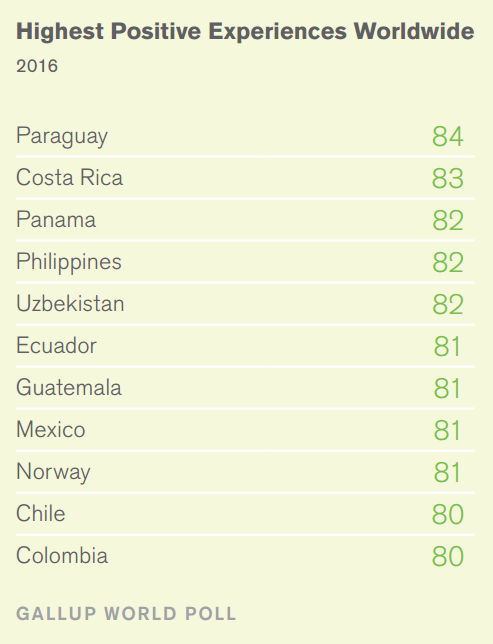
Syria obtained the lowest score in 2015, but in 2016 the country did not take part in the survey due to the security issues there.
As they have for much of the past decade, Latin American countries dominate the list of countries in 2016 where adults are reporting a lot of positive emotions each day with Costa Rica, Panama, Ecuador, Guatemala, Mexico, Chile and Colombia part of the top 10. The only countries outside this region that top this list are Uzbekistan, the Philippines and Norway.
Iraq tops the negative experience list for the fifth year
Gallup also asked adults in 142 countries in 2016 if they had five different negative experiences on the day before the survey. The questions focused on whether they experienced physical pain, worry, sadness, stress and anger.
The Negative Experience Index score is the mean of all valid affirmative responses to these items multiplied by 100. The index score for the world in 2016 was 28, unchanged from 2015 and on the higher end of the trend since 2006. Scores worldwide ranged from a high of 58 in Iraq to a low of 12 in Kyrgyzstan.
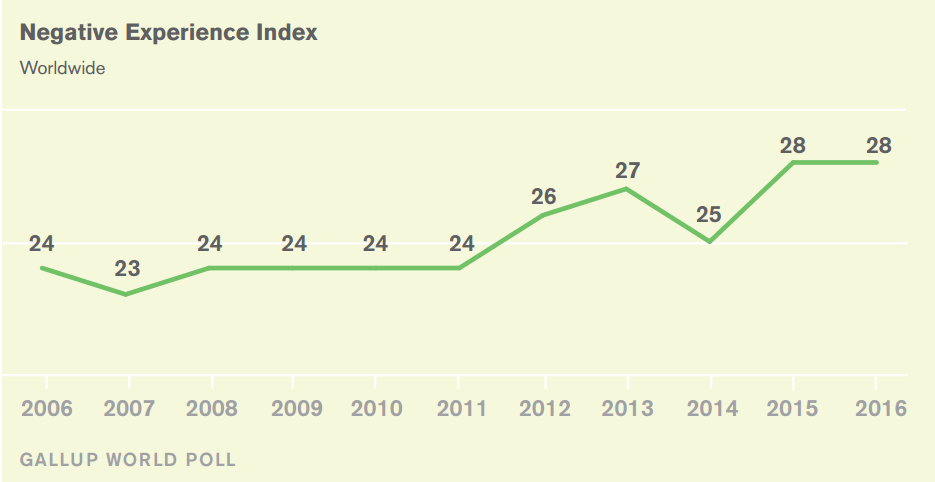
More than one in three people said they experienced a lot of worries (36%) or stress (35%), and three in 10 experienced a lot of physical pain (30%). At least one in five experienced sadness (22%) or anger (20%). More of the world’s countries experienced physical pain in 2016 (30%) than in 2015 (28%).
Several of the countries at the bottom of the list — Ukraine, Iraq, Yemen and Turkey — experience ongoing internal and external conflict in common.
Iraq has the highest Negative Experience Index score in the world for the fourth year in a row. Iraq has been No. 1 on this index five times — in 2011, 2013, 2014, 2015 and 2016 — and has been among the top five in all other years since 2008.
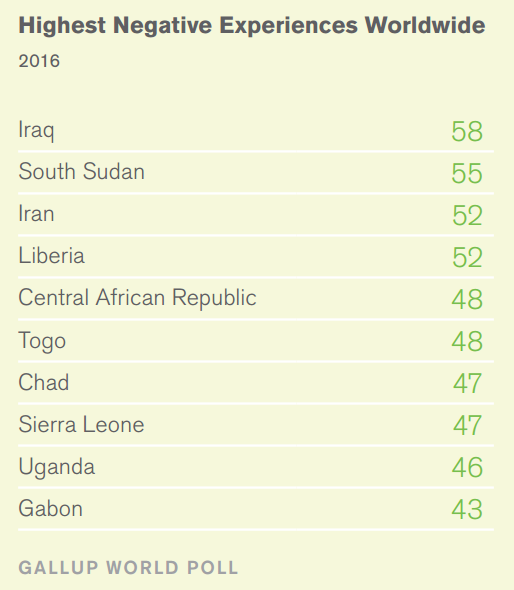
Majorities of Iraqis experienced worry (63%), physical pain (60%), stress (59%) and sadness (57%) the previous day, and half of Iraqis (49%) were angry.
Along with Iranians (50%) and South Sudanese (47%), Iraqis were the angriest populations in the world. They also tied with residents of Central African Republic (59%), South Sudan (59%) and Togo (59%) in reporting physical pain and tied with Liberia ( (55%) in reporting sadness.
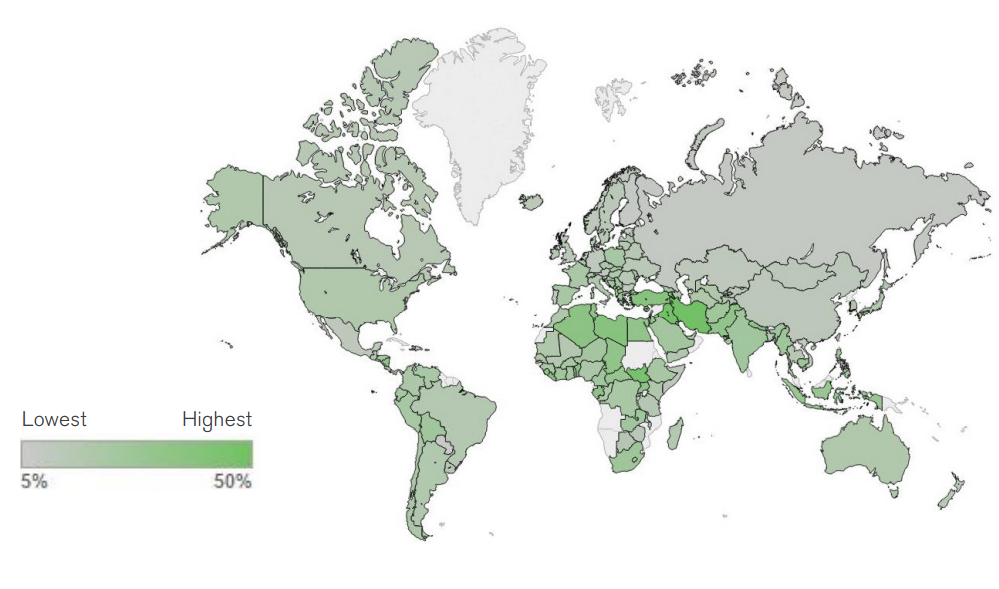
The continued presence of Iraq at the top of the list is linked to the negative scores of people’s perceptions about their living standards and health problems.
The next-highest country on the list is South Sudan, where the score increased from 46 to 55 in one year as the country is going through civil war and the population faced famine and the threat of genocide.
Greeks were the most stressed in the world
In most years, the Middle East and North Africa (MENA) region alone has posted the lowest score among all global regions on the Positive Experience Index. But in 2016, MENA tied with another region, the post-Soviet states, for the lowest score (63). All countries in the post-Soviet states region except two, Uzbekistan and Kyrgyzstan, had scores lower than the global mean.
However, while majorities of Iraqis reported experiencing stress and worry, they were not the most stressed in the world or the most worried in 2016. In Greece, more than two in three residents (67%) said they experienced a lot of stress the previous day — the highest percentage in the world — as Greeks continued to grapple with unemployment rates above 20%.